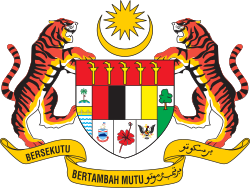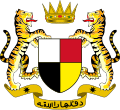Wappen Malaysias
 | |
| Details | |
| Eingeführt | 1963 (erste Version) |
| Schildhalter | 2 Tiger |
| Wahlspruch (Devise) | Bersekutu Bertambah Mutu |
| Vorgänger- versionen | |
Das Wappen Malaysias besteht aus einem mehrfach gegliederten Schild, in dem die malaysischen Bundesstaaten repräsentiert sind. Über dem Schild finden sich der goldene vierzehnzackige Stern über einem liegenden goldenen Halbmond aus der Flagge Malaysias. Schildhalter sind zwei Tiger, unter dem Schild befindet sich ein goldenes Spruchband mit dem malaysischen Staatsmotto Bersekutu Bertambah Mutu (in Latein- und Jawi-Schrift), zu Deutsch „Einheit ist Stärke“. Das Wappen wurde nach der Gründung Malaysias 1963 angenommen; durch die häufigen Änderungen der Wappen einiger Bundesstaaten und den Austritt Singapurs aus dem Bund im Jahr 1965 wurde auch das Staatswappen mehrfach modifiziert. Es ist auch Bestandteil der Flagge des malaysischen Königs.
Der Wappenschild
Der Wappenschild besteht aus sieben Feldern, die alle 13 Bundesstaaten Malaysias sowie den Staat selbst repräsentieren und großenteils den Wappen der Bundesstaaten entnommen sind:
- Im Schildhaupt in Rot fünf goldene Krummdolche (Kris), sie stehen für die fünf ehemaligen Unföderierten Malaiischen Staaten Johor, Kedah, Kelantan, Perlis und Terengganu.
- Im zweiten Feld in Weiß eine natürlich dargestellte Betelpalme, darunter in Gelb eine schwarze Hängebrücke (für die Penangbrücke, die die Insel Penang mit dem Festland verbindet), darunter blau-weiße Wellenlinien, das Feld steht für Penang.
- Das Feld an der Herzstelle ist senkrecht schwarz-rot-weiß-gelb gestreift. Die Farben stehen für die vier Föderierten Malaiischen Staaten und befanden sich bereits in Flagge und Wappen der Föderation: Rot, Schwarz und Gelb für Negeri Sembilan, Schwarz und Weiß für Pahang, Schwarz, Weiß und Gelb für Perak sowie Rot und Gelb für Selangor.
- Im vierten Feld in Weiß ein natürlich dargestellter Melaka- oder Amlabaum (Phyllanthus emblica) auf grünem Grund für Malakka.
- Das fünfte Feld rechts der Spitze steht für den Staat Sabah, es zeigt in Weiß das Staatswappen:
- Im mittleren Feld in der Spitze in Weiß eine rote Hibiskus-Blüte; der Hibiskus ist die Nationalblume Malaysias. Bis zu dessen Austritt aus der Föderation von Malaysia stand das Feld für Singapur.
- Im letzten Feld links der Spitze in Weiß ein Rhinozerosvogel (Buceros rhinoceros), das Wappentier von Sarawak.
Die anderen Elemente
Das Gelb von Stern, Halbmond und Spruchband ist die Farbe der Monarchie in Malaysia. Die vierzehn Zacken des Sterns symbolisieren die 13 Bundesstaaten und die Einheit Malaysias beziehungsweise die Bundesterritorien. (Ursprünglich war die vierzehnte Spitze für Singapur vorgesehen, das jedoch später die Föderation Malaysias verließ.) Der Halbmond steht für den Islam, die malaysische Staatsreligion. Die beiden Tiger sind alte Herrschaftssymbole und waren bereits Schildhalter des Wappens der Föderation Malaya.
Weblinks
- Beschreibung auf flaggenlexikon.de
- Wappenbeschreibung (englisch)
- Beschreibung der malaysischen Königsflagge (Memento vom 26. Februar 2009 im Internet Archive) (englisch)
- Abbildung und Erklärung des Wappens von Sabah (englisch)
Auf dieser Seite verwendete Medien
scheme of Malaysian coat of arms
- selfmade by Pitichinaccio 13:53, 10 July 2006 (UTC)
The coat of arms of Malaysia used between 1963 and 1965, when Singapore was a state within the Federation of Malaysia. The elements of the coat of arms are as follows:
- Crest. The crest consists of a yellow crescent and yellow 14-pointed "Federal Star" (Bintang Persekutuan). The yellow colour represents the monarchy of the country, the crescent represents Islam which is the official religion, and the points of the star represent the states of Malaysia.
-
Escutcheon. The escutcheon or shield consists of a chief (upper portion) and a lower section that is divided in three per pale (longitudinally).
- Chief. The chief of the escutcheon is gules (red) charged with five krises (Malay daggers), representing the five former Unfederated Malay States: Johor, Kedah, Kelantan, Terengganu and Perlis.
- Dexter (left side from the observer's point of view). In the dexter section is the escutcheon of the former coat of arms of Penang which was blazoned "Barry wavy of eight Azure and Argent upon a chief crenellée Or a plume of three ostrich feathers surmounted by a riband of the First on the riband the words Ich Dien in letters of the Third". The Prince of Wales's feathers and the motto "Ich Dien" ("I serve") refer to Penang's founding in 1786 as Prince of Wales Island, while the blue and white bars refer to the Straits of Malacca which surround the island.
- Upper middle section. In the upper middle section below the chief are the colours of the Federated Malay States (red, black, white and yellow) arranged from left to right. The permutations of the colours make up the colours of these states' flags: red, black and yellow for Negeri Sembilan; black and white for Pahang; black, white and yellow for Perak; and red and yellow for Selangor.
-
Lower middle section. In the lower middle section are three sections representing the new states of Sabah, Singapore and Sarawak which joined the Federation of Malaysia in 1963.
- Sabah. The section representing Sabah is a crest from the coat of arms of the British North Borneo Chartered Company which consists of two human arms grasping a flag flowing to the sinister (right from the observer's point of view). The arm on the right is in a sleeve and appears to represent a white person, while the arm on the left is bare and has darker skin which may represent an indigenous Malay person. The flag appears to be the flag of Sabah used between 1963 and 1982.
- Singapore. The section representing Singapore consists of a white crescent below a pentagon of five white five-pointed stars, which are from the flag of Singapore. The waxing crescent moon represents a young state on the ascendant, and the five stars the state's ideals of democracy, peace, progress, justice and equality.
- Sarawak. The section representing Sarawak is based on the flag of Sarawak used between 1963 and 1973 which consists of a half-black, half-red cross on a yellow field defaced with a five-pointed Eastern crown.
- Sinister (right side from the observer's point of view). In the sinister section is a Malacca tree (Phyllanthus emblica), after which the state was named.
- Supporters. The two rampant tigers supporting the escutcheon are traditional Malay symbols. They were retained from the earlier armourial ensigns of the Federated Malay States and Federation of Malaya, and symbolise strength and courage.
- Motto. The motto is "Bersekutu Bertambah Mutu" ("Unity is Strength") in both Latin script and Jawi script.
This is the coat of arms of former British colonies the Federated Malay States (1896-1942), the Malayan Union (1946-1948) and the Federation of Malaya (1948-1950).









